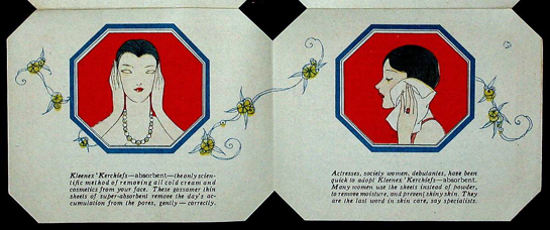 |
| Kleenex logo 1924 |
Name: "Kleenex"
Category: Health and Beauty
Subcategory: Facial tissues
Inventor / Producer: Cellucotton Products Co.
(formed in 1924 as a division of Kimberly, Clark and Co., founded in 1872 by John A. Kimberly, Havilah Babcock, Charles B. Clark, and Franklyn C. Shattuck)
Production start: June 12, 1924 - Neenah, Wisconsin, USA
First price: In 1926, Kleenex Absorbents 'Kerchief cost 35 cents in Boudoir size (sheets 6 by 7 inches), 65 cents in Professional (sheets 9 by 10 inches). A free 7-day sample pack supply was offered to try it.
Features: The first Kleenex handkerchiefs were made of "Cellucotton", a preparation from processed wood pulp. A variation of the cylinder machines, the Yankee paper machines dried the cellulose web on a single steam-heated cylinder featuring a polished surface, unlike the fourdrinier machine that dried the web in press rolls.
Interesting facts: During World War I, a shortage of cotton for bandages forced the military to look for an alternative. Kimberly-Clark came to the rescue with a "Cellucotton" (cellulose + cotton) product that would later become Kleenex. It was a clean product for dressing wounds and was also used in gas masks. After the war, the company faced a marketing dilemma as they had massive stockpiles of Cellucotton and a sudden end of demand for the product. In a stroke of marketing genius, Kimberly-Clark began to sell the war surplus as a cold cream and makeup remover. In 1920 Kimberly-Clark forms the company Cellucotton Products Co. to market Kotex (cotton + texture) sanitary napkins. In 1924 Kleenex (Cleansing + Kotex) was introduced by Cellucotton and first marketed to women as a disposable towel to use when removing cold cream. Made of the extra pulp from producing Kotex pads, Kleenex became a cleansing-cloth replacement. In a short time, however, consumers began using tissues as disposable handkerchiefs. The first pop-up tissue box appeared in 1928. In the USA, the Kleenex name has become genericized: the popularity of the product has led to the use of its name to refer to any facial tissue, regardless of the brand, and many dictionaries now include definitions in their publications defining it as such.
Slogan (1926): «We have found the only way ever known -that removes Cold Cream thoroughly -that remove it safely -that removes all dirt with it»
Property: Kimberly-Clark Corporation
Official website: https://www.kleenex.com
 |
| Kleenex, the origins. Left: Kimberly-Clark launches the Cellucotton, a substitute of absorbent cotton, made from wood (article from The Capital Times, Dec. 20, 1917). Center: Cellucotton Product Company is established to handle product (Appleton Post Crescent, Oct. 16, 1920). Right: Demand increases and plants expand (Appleton Post Crescent, Dec. 11, 1922). |
 |
| Kleenex, patented logo (1924, filed on July 12 and registered on November 25, for "Absorbent pads or sheets for removing cold cream") |
 |
 |
| Kleenex Sanitary Cold Cream Remover, first packages (1924) |
 |
| Kleenex, window display Cellucotton product line (1926) |
 |
| Kleenex, advertising with famous American actress Dolores Costello (1926) |
 |
 |
 |
| Kleenex Absorbents 'Kerchief, advertising booklet (Feb. 1926) |
 |
| Kleenex Sanitary Cold Cream Remover, advertisement (Good Housekeeping, Feb. 1926) |
 |
| Kleenex Sanitary Cold Cream Remover, advertisement (Theatre Magazine, May 1926) |
 |
| Kleenex Absorbents 'Kerchief, regular and pop-up tissue package (1928) |
 |
 |
| Kleenex Cleansing Tissues, pop-up box prototype (Feb. 1929) and first model (1930) |
 |
| Kleenex Cleansing Tissues, advertisement introduces new smart colored packages (1930) |
 |
Kleenex Cleansing Tissues, advertisement with famous American actress Helen Morgan
(True Romance, Sept. 1930) |
 |
Kleenex Cleansing Tissues, advertisement with famous American actress Laura La Plante
(Pictorial Review, July 1931) |
 |
 |
| Kleenex Disposable Tissues, window display (1938). The window of the Bechberger and Kubach drugstore, Sloane House, Sandusky (Ohio), featured a display entitled "IT'S KLEENEX TIME in America!". The display showed the Seven Dwarfs explaining why they liked Kleenex. |
 |
 |
| Kleenex Disposable Tissues, window display (1938). The window of the Kassis store, Laramie (Wyoming), featured a large display of Kleenex with dolls and a mannequin. |
 |
| Kleenex, packages timeline (1925-1966) |
 |
 |
| Kleenex celebrates its 90th anniversary (June 12, 2014) with a large-scale design project that involves collaboration with style icon Isaac Mizrahi. Bottom: Kleenex in their advanced versions. |




























